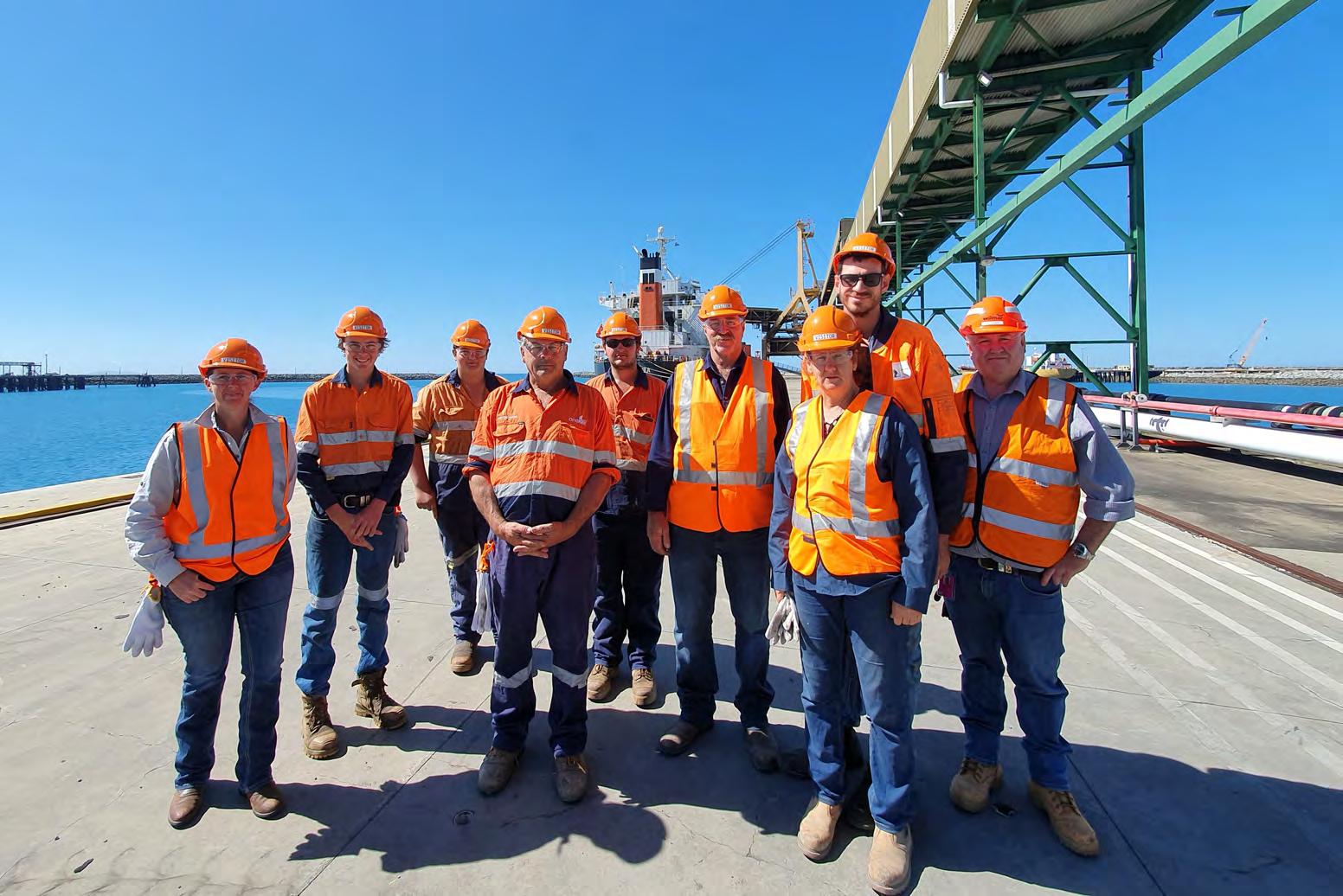
11 minute read
ON THE LAND
First 2021 season sugar shipped out of Mackay
Weekly production figures
Advertisement
Burdekin region mills Weekly production figuresWeek 9, ending 07 August 2021 Cane crushed This week Season to date Burdekin region mills Week 9, ending 07 August 2021 Cane crushed This week Season to date Invicta 163,153 1,302,078 Pioneer 89,274 698,328 Kalamia 84,527 643,676 Invicta 163,153 1,302,078 Pioneer 89,274 698,328 Kalamia 84,527 643,676 Inkerman 88,790 529,603 Burdekin 425,744 3,173,685 Inkerman CCS 88,790 529,603 Burdekin Invicta 425,744 15.13 3,173,685 14.22
Pioneer
CCS Invicta Pioneer Kalamia Kalamia Inkerman Burdekin 15.13 15.03 14.55 15.03 14.55 14.95 14.96 14.22 14.21 13.82 14.21 13.82 13.70 14.05
Inkerman 14.95 Weekly variety performance for region 13.70 Burdekin Variety % CCS 14.96Variety % 14.05 CCS
Q240 47 15.03 Q208 10 14.64 Weekly variety performance for region KQ228 22 14.80 Q183 9 15.67
VarietyQ232 %10 CCS 14.64 Variety % CCS
Q240 47 15.03 Q208 10 14.64 KQ228 Comments: 22 14.80 Q183 9 15.67
Q232 10 14.64 The Burdekin mills crushed more than 425,000 tonnes of Comments: cane for the week – the highest weekly throughput so far this season. All four Burdekin mills crushed above budget. Invicta, Kalamia and Inkerman all posted the highest throughputs for the year. Pioneer fell just shy of another 90,000 tonne week. Kalamia recorded the best weekly throughput since 2005. Cane continues to be transferred out of the Inkerman area to Pioneer and Invicta mills for processing. Total throughput for the season to date is now just over 3 million tonnes. Average weekly CCS was 14.96 which is now nearly 0.5 units above budget. The highest CCS sample was 18.3 from a rake of Q240 fourth ratoon in the Inkerman Mill area.
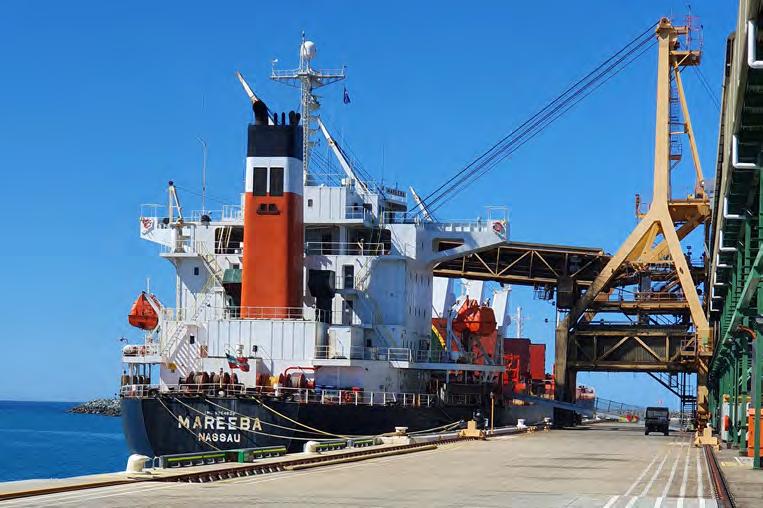
The Burdekin mills crushed more than 425,000 tonnes of cane for the week – the highest weekly throughput so far this season. All four Burdekin mills crushed above budget. Invicta, Kalamia and Inkerman all posted the highest throughputs for the year. Pioneer fell just shy of another 90,000 tonne week. Kalamia recorded the best weekly throughput since 2005. Cane continues to be transferred out of the Inkerman area to Pioneer and Invicta mills for processing. Total throughput for the season to date is now just over 3 million tonnes. Average weekly CCS was 14.96 which is now nearly 0.5 units above budget. The highest CCS sample was 18.3 from a rake of Q240 fourth ratoon in the Inkerman Mill area.
John Tait Cane Supply Manager Burdekin Region John Tait Cane Supply Manager Burdekin Region

Pictured at the Mackay Terminal are, from left, Kristy Thomsett, Ryan Thomsett, Ben Axiak, Vic Axiak, Sam Axiak, Peter Thompson, Desley Thompson, Daniel Thompson and Angus McKerrow.
Wilmar Sugar
THE first raw sugar of the 2021 season has shipped out of the Port of Mackay.
Local growers looked on as raw sugar produced at Wilmar’s Plane Creek and Proserpine mills was loaded into the MV Mareeba bulk carrier.
It was destined for Sugar Australia’s Yarraville Refinery in Melbourne where it will be processed into a wide range of sugar products for the iconic CSR Sugar brand and for Australian food and beverage customers.
The Mackay Port tour was organised by Wilmar’s Plane Creek Grower Marketing Consultant Angus McKerrow and Mackay Sugar Terminal Mechanical Supervisor Hamish Beveridge to give cane growers greater insight into the sugar supply chain that begins on their farms and ends on supermarket shelves in Australia and overseas.
Mr McKerrow said nine growers from the Plane Creek region attended the port tour on 20 July.
“The growers were excited to witness raw sugar that originated from their local mill and potentially, their farms, being loaded into a ship.
Mr McKerrow said the growers got an appreciation for the processes around storing and loading sugar, and the procedures around quality sampling.
“The logistics of handling sugar – from delivery, through to storage and loading – are quite complex, and there are a lot of controls in place to maintain the quality of that sugar from port to port.
The MV Mareeba took the first shipment of 2021 season sugar out of the Port of Mackay.


On the Land is proudly supported by
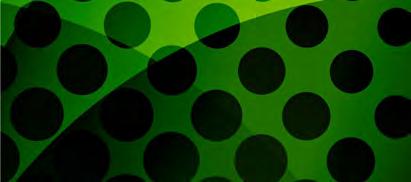

$2 BILLION SUGAR CRUSH REACHES 25% MILESTONE
Australian Sugar Milling Council
AUSTRALIA’S $2 billion sugarcane crush has passed the 25% mark with more than 8 million tonnes of the estimated 31.4 million tonnes having been processed.
This compares favourably to the same time last year when 7.4 million tonnes had been crushed. A pleasing feature of this year’s crop is that the average sugar level is up significantly this year with the Australian average to date sitting at a CCS (commercial cane sugar or sugar content) level of 13.
The Australian Sugar Milling Council’s Director, Industry and Government Affairs Jim Crane says after a difficult start to the season with rain disrupting the harvest in all regions, mills are working under COVID safe conditions and now edging towards weekly totals of around 1.5 million tonnes crushed per week.
“It’s critical for the sugarcane crush to be progressing as the industry supports 23,000 jobs,” Mr Crane said.
Mr Crane said that with 25% of the crop harvested, the 31.4 million tonnes estimate remains current although this was an outcome of it cutting out slightly above estimate in some regions and below in other regions.
“Raw sugar production has now passed 1 million tonnes for the season. With improved sugar prices prevailing, this production to date is valued at more than AU$500 million,” he concluded.
New northern spice industry gains momentum
CQUniversity
THE results are in from the 2020/21 summer black sesame field trials, during which the CQUniversity Spicing Up Northern Australia research project expanded from small plot varietal assessments to larger areas for bulking up seed supplies.
Across the six regions participating in the project, spanning Central and North Qld and the Northern Territory, there were two growers in each area, plus an additional grower from the Ord area of Western Australia, demonstrating growing excitement at the potential for the development of a viable black sesame industry across Northern Australia.
Such is the growing inquiry from farmers that seed company AgriVentis Technologies has this week appointed a new agronomist, Andrew McDonald, to work with growers across Northern Australia in maximizing yields and returns as they learn the nuances of growing spices.
“It’s a really exciting time to be involved in the cropping industry with so much interest and opportunity in Northern Australia to expand production and establish new crops that are suited to the unique and often challenging conditions of the region,” Mr McDonald said.
CQUniversity is leading the large-scale research project funded by the CRC for Developing Northern Australia, part of the Australian Government’s CRC Program and supported by AgriVentis, and has been assessing the suitability of black sesame, fennel, carraway, kalonji, and cumin to broadacre production.
Lead researcher Dr Surya Bhattarai, of CQUniversity, said high black sesame crop yields had now been proven, but two big challenges remained in minimising losses from machine harvesters and refining weed control strategies.
“The summer trial results showed hand-harvested yields from the sample plots ranged from 306 to 2607kg/ha, while machine harvested seed yield ranged from 85-1088kg/ha, with the difference attributed to significant seed loss in the machine harvest,” Dr Bhattarai said.
Meanwhile, winter planting has now been completed at all research sites across Northern Australia, with fennel, kalonji and black sesame planted in trials targeting specific crops to specific environmental conditions. Carraway and cumin have not been included after they did not perform well enough in preliminary trials to warrant further assessment.
Kalonji has been planted at three sites at Rockhampton, while kalonji and fennel have planted in Biloela. Black sesame and fennel – both previously assessed as summer crops – were planted in Ayr and Tully in July to trial as winter crops along with kalonji, while in the NT fennel will also be trialled as winter crop.
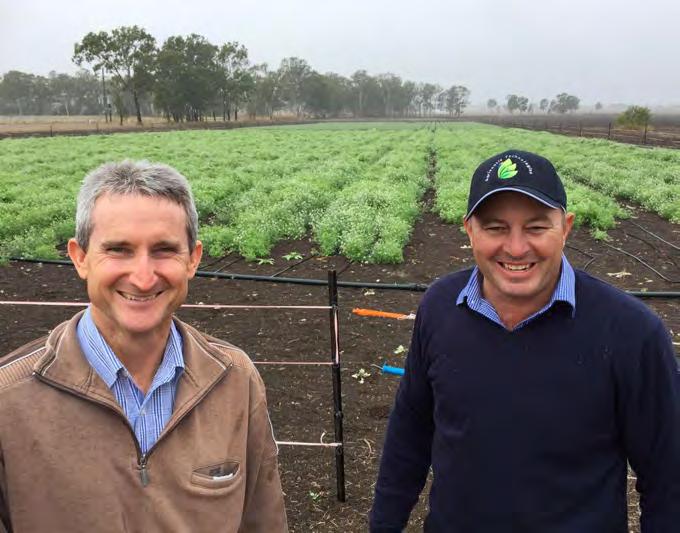
CONNECT NOW:
More information is available at https:// crcna.com.au/research/projects/ spicing-northern-australia-high-valuecondiment-crops
QSL Market Update current as of 10 August 2021
Raw Sugar prices
• A further downgrading of the Centre South (CS) Brazil sugarcane crop saw raw sugar prices spike at the later stage of last week, pushing the front ICE 11 raw sugar futures contracts out to new life-of-contract highs. The October 2021 contract traded from a weekly low on the Tuesday of 17.74
USc/lb up to a new high of 18.92 USc/lb on Friday before closing the week up 4.3% at 18.68 USc/lb. • Now that the dust has settled from the third frost in CS
Brazil cane regions, traders have once again reduced their 2021-Season forecasts, leading some to believe that Brazilian sugar producers may be over-hedged. One Asian-based trade house announced they have revised their Brazilian estimate down to 490-500 million tonnes of cane and 28 million tonnes of sugar, well below the current market consensus of 31-33 million tonnes of sugar. • To fill the supply gap created by a smaller CS Brazil crop, the market is looking to India to export additional tonnage, now made viable by rising ICE 11 sugar prices. Some reports suggest India has already committed to 800,000 tonnes of export sugar for the 21/22 Season. • The Brazilian currency softened 1.8% across the week, with the Real trading at 5.24 vs the US Dollar. Firming ethanol prices in Brazil pushed spot ethanol parity to strengthen slightly at 17.58 USc/lb equivalent. • As of Tuesday 3 August, speculators maintained their large net-long position of 213,000 lots, slightly down week on week. Given the significant rally on 5/6 August, this position is likely to be 10-20,000 lots larger on a live basis.
2021-SEASON RAW SUGAR PRICES
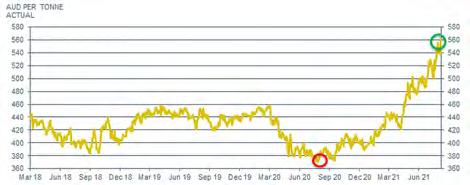
This is a whole-of-season ICE 11 price chart for the 2021 Season, based on the current 3:2:1 pricing ratio applicable to QSL Target Price Contract growers. Source: Bloomberg
Currency
• For a second week in a row the Australia Dollar (AUD) floated in the 73-74 US cent range as global markets entertain further risk-on appetite. The AUD hit its weekly low of 73.29 US cents last Monday before trading to a high of 74.27 US cents on Wednesday and eventually closing the week almost flat at 73.56 US cents. • The Reserve Bank of Australia (RBA) met for its August meeting last Tuesday and, despite extended lockdowns in Sydney and a sixth lockdown in Victoria, remained optimistic towards Australia’s economic recovery. Markets were surprised when the RBA stuck to its plans of tapering its quantitative easing purchases from $5 billion per week to $4 billion per week starting in early September. • The US labour market made headlines last Friday, printing significantly stronger data for the month of July. The unemployment rate fell from 5.9% to 5.4% and non-farm payrolls rose 943,000 jobs across the month. Average hourly earnings and the participation rate also surprised to the upside, leading markets to believe the Fed could announce a tapering to its own quantitative easing program sooner rather than later. • In China, an outbreak of the Delta variant of COVID-19 put markets on high alert. Case numbers are now over 300 so far, spread across almost half of the 32 provinces. Brent crude oil prices weakened to $US72.51 per barrel after a
Chinese analyst predicted a potential 5% decline in demand from this latest wave of the infection.
To read our full commentary in the QSL Market Update, please visit www.qsl.com.au or contact the Burdekin QSL team: Russell Campbell, Grower Relationship Manager 0408 248 385 Kristen Paterson, Grower Relationship Officer 0438 470 235 Rebecca Love, Grower Relationship Officer 0429 054 330
This report contains information of a general or summary nature. While all care is taken in the preparation of this report, the reliability, accuracy or completeness of the information provided in the document is not guaranteed. The update on marketing and pricing activity does not constitute financial, investment advice. You should seek your own financial advice. Nothing contained in this report should be relied upon as a representation as to future matters. Information about past performance is not an indication of future performance. QSL does not accept any responsibility to any person for the decisions and actions taken by that person with respect to any of the information contained in this report..



